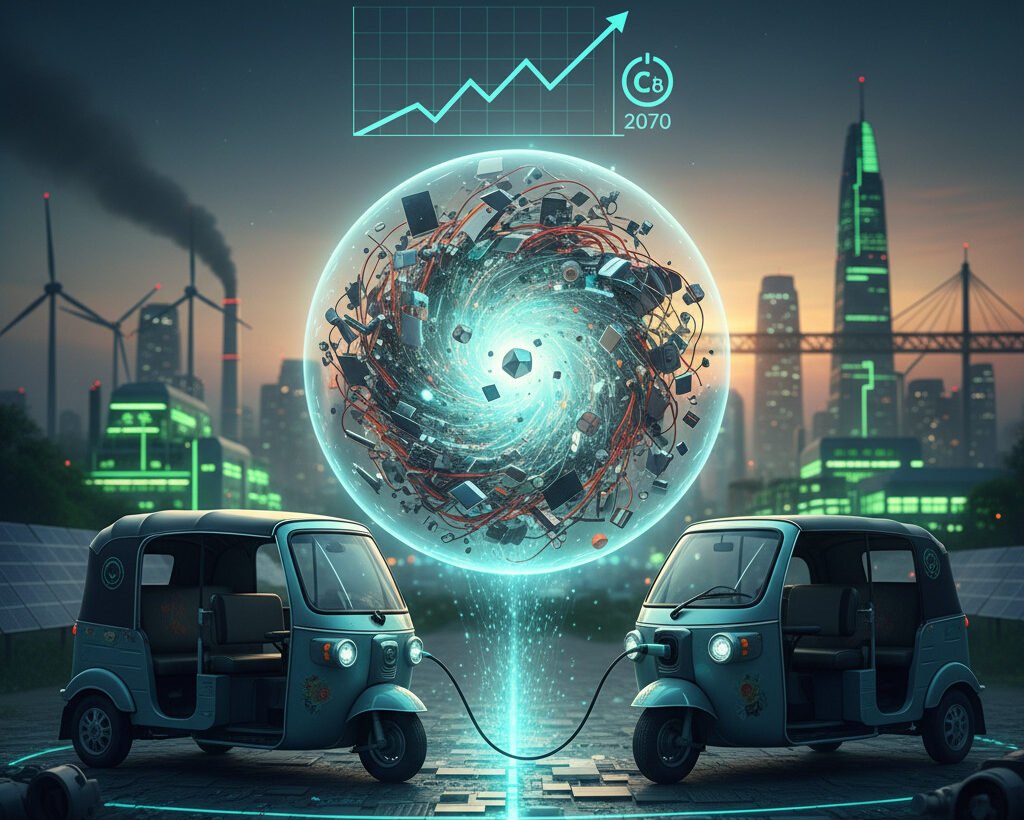New Delhi — The world’s third-largest producer of electronic waste, India, is preparing to turn discarded phones, laptops, and gadgets into a new source of power for its growing electric vehicle (EV) industry.
In a move that could redefine both e-waste management and industrial sustainability, the Ministry of Electronics and Information Technology (MeitY) has proposed to the Ministry of Heavy Industries (MHI) that the recycling of old rare earth magnets (REPMs) be included under the government’s upcoming Production Linked Incentive (PLI) scheme.
The initiative is being hailed as a significant step toward self-reliance in rare earth supply, a field currently dominated by China, while also aligning with India’s broader green manufacturing and carbon neutrality goals.
India’s March Toward Carbon Neutrality by 2070
According to MeitY, as India moves rapidly toward its goal of achieving net-zero emissions by 2070, the amount of electronic waste will also increase sharply.
With the expanding demand for EVs and consumer electronics, the volume of used or discarded REPMs—found in motors, speakers, and batteries—is set to rise significantly.
Promoting organized recycling, officials say, will not only reduce environmental pressure but also cut India’s dependence on imported raw materials, especially as China continues to restrict REPM exports.
FCRF Launches CCLP Program to Train India’s Next Generation of Cyber Law Practitioners
China’s Ban and Its Ripple Effects
Since April 2025, China has imposed a ban on the export of REPMs to India, a decision that sent shockwaves through the country’s automotive and electronics industries.
China currently accounts for around 90% of global REPM production, and the export ban immediately disrupted supplies for products such as earphones, smartwatches, and EV traction motors.
Although Indian companies managed to establish alternative supply chains in time, concerns remain about long-term supply security and industrial resilience.
PLI Scheme: Laying the Foundation for a Self-Reliant Future
Under the proposed PLI framework, the Ministry of Heavy Industries plans to set up five manufacturing plants across the country, with a combined annual capacity of 6,000 tonnes.
The scheme aims to offer capital subsidies and sales-linked incentives to private manufacturers, promoting domestic production of REPMs and related components.
MeitY, however, has pushed for recycling to be made an integral part of the initiative, arguing that it will ensure a transparent, organized, and eco-friendly process.
The MHI, on the other hand, maintains that recycling falls under the jurisdiction of the Ministry of Mines, making its inclusion in the PLI scheme “procedurally complex.”
India’s E-Waste Reality Check
According to the Global E-Waste Monitor 2022, India generated 4.17 million tonnes of e-waste in 2022, ranking third globally after China and the United States.
Most of this waste comes from discarded phones, televisions, computers, and household devices.
Experts believe that recovering rare earth magnets and metals from these discarded products could provide India with a domestic source of critical raw materials for the EV, semiconductor, and defense industries, significantly reducing dependence on imports.
ICEA’s Warning: Delays Could Derail Key Sectors
The India Cellular and Electronics Association (ICEA) has cautioned that continued disruption in REPM supply could negatively impact EV production, semiconductor manufacturing, and defense electronics.
In FY 2024–25, India’s electronics manufacturing output reached $138 billion (₹11.5 lakh crore), with mobile phones contributing nearly $64 billion (₹5.3 lakh crore).
This marks India’s emergence as a global electronics manufacturing powerhouse, making a stable REPM supply chain both a strategic and economic necessity.
Turning Waste into Power
India’s move to recycle rare earth magnets from e-waste represents more than just an environmental initiative — it’s a blueprint for a circular, self-reliant industrial future.
If successful, this program could turn the magnetic dust from discarded smartphones into the driving force behind the nation’s electric vehicles, powering the next generation of clean mobility.
It’s a bold vision — one where waste transforms into wealth, and every old gadget plays a small role in building a cleaner, greener India.


